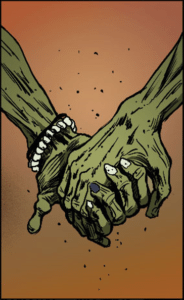Morte
Kevin Joseph, D.A. Bishop
Source Point Press
November 2017
For some readers, the idea of a silent comic is one of very little value: where is the marriage of words and images to create a liminal work of art, halfway between the visual and the literary? If a comic is images-only, doesn’t that take something away from the form? Morte by Kevin Joseph and D.A. Bishop challenges these questions and raises a question of its own: in a post-apocalyptic world, where you’re the last human surviving, what do you do with your days?
Morte’s answer is surprisingly sweet. A single human being wanders the streets with a purpose, a pull-cart and an oddly tender ambition, to reunite families after death. While it’s not made clear exactly what has caused all these people to suddenly drop dead–at work, school, home–the generic post-apocalyptic world is well-rendered in decaying shades of brown and grey, and we as readers can understand that the focus isn’t necessarily on what happened, but what happens next. Like the question of who watches the watchmen, Morte asks the important question of what happens to all the bodies of the people who were once alive after a catastrophic disaster. The idea of a strange guardian-of-sorts doing his best to give these people their dignity is an appealing one and is illustrated both as the major arc of the comic and in individual, small moments, such as entwining the fingers of a teenage couple together before he continues.
Considering the comic is silent, it needs to remain that way throughout, even being devoid of sound effects. The pulp-like “CHOK!” of a spade into soil, or the “jingle” of a bell isn’t needed. Likewise, neither is the protagonist’s single spoken word. It makes sense that, alone in the world, the protagonist might not bother speaking, and when, halfway through, they do speak, this threatens to break the tension of the narrative and the resolve of the protagonist. The comic’s early onomatopoeic moments, too, break the tension. Instead of page five’s “snap!” of a breaking lock, coloured in a glaring yellow, the lock could just be shown breaking in an additional panel. These moments of sound, in written form, also slightly dilute the written information the protagonist collects and uses. Wall signs, school timetables, and handwritten notes feel less serious if they are placed near one of the panels with a sound effect.
That aside, Morte introduces the reader to a story already told–the end of the world–but also continues and makes something new out of it, with no need for speech to convey a moving, thoughtful consideration of “what happens next?” The moment the protagonist’s ultimate intention is revealed it threatens to be funny rather than gently humorous. Is their intention more ridiculous than caring to set up a group of corpses with an old-fashioned board game? However, the comic’s following page is entirely devoted to one panel, showcasing the bittersweet realisation of a once-loving family’s casual physicality and intimacy with each other. Short, quick-action panels show the progressive creation of the family’s ultimate resting place, with the focus not so much on the protagonist as their provision of a final, peaceful resting place. Linking back to the book’s first, full-panel page, the final page shows the protagonist leaving for his next mission, while we, the reader, seem to stay behind with the family, watching as the last person on earth attempts to do something worthwhile with their time.



